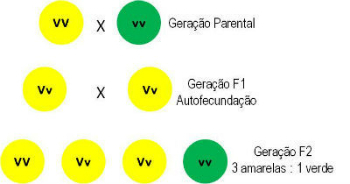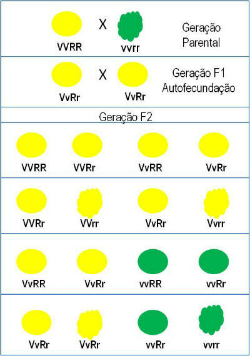At Mendel's Laws they are a set of fundamentals that explain the mechanism of hereditary transmission over generations.
The studies of the monk Gregor Mendel were the basis for explaining the mechanisms of heredity. Even today, they are recognized as one of the greatest discoveries in biology. This led to Mendel being considered the "Father of Genetics".
Mendel's Experiments
To conduct his experiments, Mendel chose sweet peas (Pisum sativum). This plant is easy to grow, self-fertilizes, has a short reproductive cycle and is highly productive.
Mendel's methodology consisted in performing crosses between several strains of peas considered "pure". The plant was considered pure by Mendel when after six generations it still had the same characteristics.
After finding the inbred lines, Mendel began to perform crosses of cross-pollination. The procedure consisted, for example, of removing pollen from a plant with yellow seeds and depositing it under the stigma of a plant with green seeds.
The characteristics observed by Mendel were seven: flower color, flower position on the stem, seed color, seed texture, pod shape, pod color and plant height.
Over time, Mendel carried out different types of crosses in order to verify how the characteristics were inherited over the generations.
With that, he established his Laws, which were also known as Mendelian Genetics.
Mendel's Laws
Mendel's First Law is also called Factor Segregation Law or Moibridism. It has the following statement:
“Each character is determined by a pair of factors that separate in the formation of gametes, going one factor of the pair for each gamete, which is therefore pure.”.
This Law determines that each characteristic is determined by two factors, which are separated in the formation of gametes.
Mendel reached this conclusion when he realized that different strains, with the different attributes chosen, always generate pure seeds and without changes over the generations. That is, yellow seed plants always produced 100% of their offspring with yellow seeds.
Thus, the descendants of the first generation, called the F generation1,were 100% pure.
As all the seeds generated were yellow, Mendel performed self-fertilization among them. In the new lineage, generation F2, yellow and green seeds appeared, in a 3:1 ratio (yellow: green).

Crossroads of Mendel's First Law
With that, Mendel concluded that the color of the seeds was determined by two factors. One factor was dominant and conditions yellow seeds, the other was recessive and determines green seeds.
know more about Dominant and Recessive Genes.
Mendel's First Law applies to the study of a single feature. However, Mendel was still interested in knowing how the transmission of two or more characteristics occurred simultaneously.
Mendel's Second Law is also called Law of Independent Segregation of Genes or Diibridism. It has the following statement:
“differences in one feature are inherited regardless of differences in other features.”.
In this case, Mendel also crossed plants with different characteristics. He crossed smooth yellow seed plants with wrinkled green seed plants.
Mendel already expected that the F generation1 it would be composed of 100% of yellow and smooth seeds, as these characteristics have a dominant character.
So he crossed that generation, because he imagined that green and wrinkled seeds would come out, and he was right.
The crossed genotypes and phenotypes were as follows:
- V_: Dominant (Yellow color)
- R_: Dominant (smooth shape)
- vv: Recessive (Green color)
- rr: Recessive (Rough shape)

Crossroads of Mendel's Second Law
Mendel discovered different phenotypes in the F² generation, in the following proportions: 9 yellow and smooth; 3 yellow and wrinkled; 3 green and smooth; 1 green and rough.
Also read about Genotypes and Phenotypes.
Gregor Mendel Biography
Born in the year 1822, in Heinzendorf bei Odrau, Austria, Gregor Mendel he was the son of poor little farmers. For this reason, he entered the Augustinian monastery in the city of Brünn as a novice in 1843, where he was ordained a monk.
He subsequently entered the University of Vienna in 1847. There, he studied mathematics and science, conducting meteorological studies on the life of bees and plant cultivation.
From 1856 onwards, he began his experiment by trying to explain the hereditary characteristics.
His study had been presented to the "Brünn Natural History Society" in 1865. However, the results were not understood by the intellectual society of the time.
Mendel died in Brünn in 1884, embittered at not gaining academic recognition for his work, which was only appreciated decades later.
Want to learn more about Genetics? Read too Introduction to Genetics.
Exercises
1. (UNIFESP-2008) Plant A and plant B, with yellow peas and unknown genotypes, were crossed with plants C that produce green peas. The A x C cross originated 100% plants with yellow peas and the B x C cross resulted in 50% plants with yellow peas and 50% green. The genotypes of plants A, B and C are, respectively:
a) Vv, vv, VV.
b) VV, vv, Vv.
c) VV, Vv, vv.
d) vv, VV, Vv.
e) vv, Vv, VV.
c) VV, Vv, vv.
2. (Fuvest-2003) In pea plants, self-fertilization normally occurs. To study the mechanisms of inheritance, Mendel cross-fertilized, removing the anthers from a plant flower. tall homozygous plant and placing, on its stigma, pollen collected from the flower of a short homozygous plant. stature. With this procedure, the researcher
a) prevented the maturation of female gametes.
b) brought female gametes with short stature alleles.
c) brought male gametes with alleles for short stature.
d) promoted the encounter of gametes with the same alleles for height.
e) prevented the encounter of gametes with different alleles for height.
c) brought male gametes with alleles for short stature.
3. (Mack-2007) Suppose that, in a plant, the genes that determine smooth edges of leaves and flowers with smooth petals are dominant in relation to their alleles that condition, respectively, serrated edges and mottled petals. A dihybrid plant was crossed with one with serrated leaves and smooth petals, heterozygous for this trait. 320 seeds were obtained. Assuming that they all germinate, the number of plants, with both dominant characters, will be:
a) 120.
b) 160.
c) 320.
d) 80.
e) 200.
a) 120.
4. (UEL-2003) In humans, myopia and left hand ability are characters conditioned by recessive genes that segregate independently. A right-handed, normal-sighted man whose father was nearsighted and left-handed marries a nearsighted, right-handed woman whose mother was left-handed. How likely is this couple to have a child with the same phenotype as the father?
a) 1/2
b) 1/4
c) 1/8
d) 3/4
e) 3/8
e) 3/8
